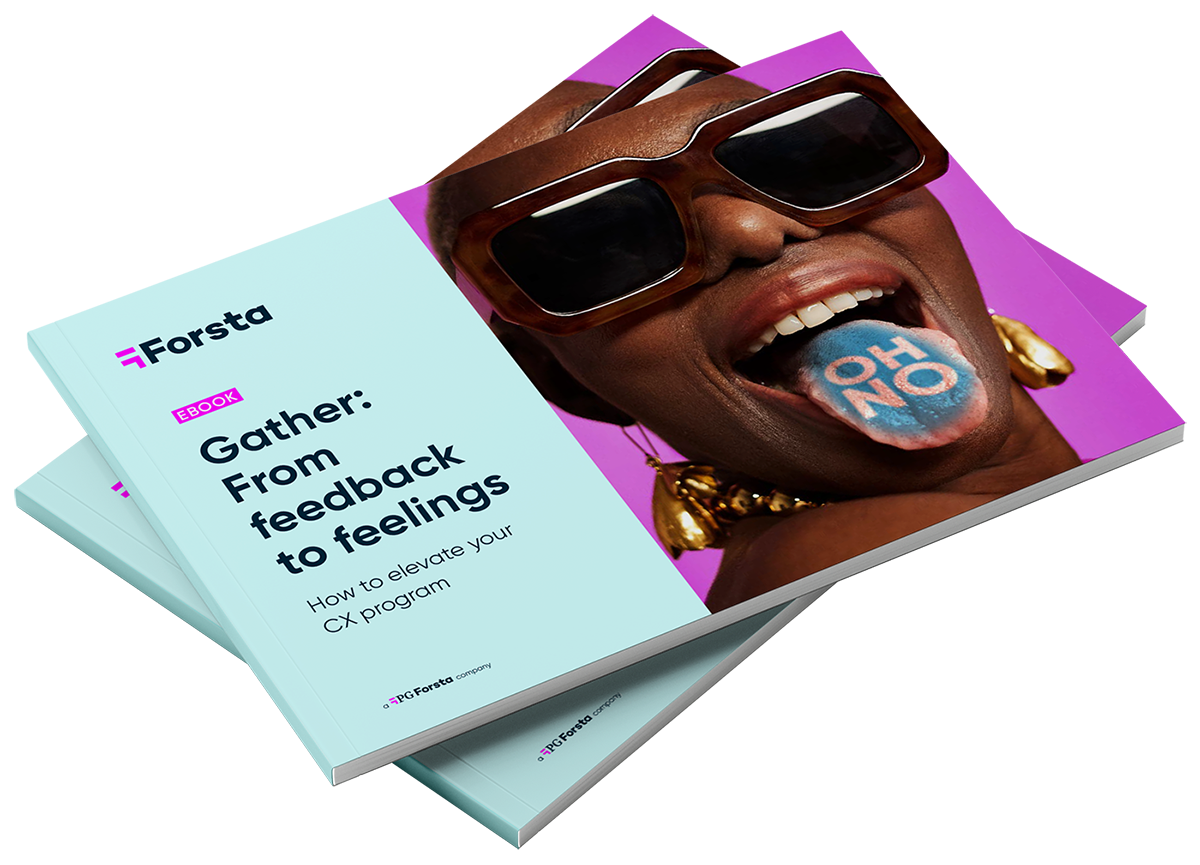Using qualitative discussions to amplify your CX program

Customer feedback is often described with scores, metrics and other numbers: Net Promoter Score, Customer Lifetime Value, Overall Satisfaction… Now these are important, and the science of Customer Experience is built on robust economics. It wouldn’t be sustainable otherwise. But the quantitative is only part of the story.
By adding the qualitative dimension, you get to the heart of the matter. Literally. You start to see customers as people. Not just buyers who have opinions and who behave in a certain way. Qualitative discussions in particular give you a depth of insights you simply can’t get any other way. A direct line of sight to your customers’ hearts, and not just their minds.
According to a Forrester Consulting study, commissioned by Forsta, 93% of companies agree that customers are more likely to spend money with a brand they feel connected to. So, let’s find out more about how you can use qualitative discussions to amplify your customer experience program and impact your bottom line.
What are qualitative discussions?
We call qualitative discussions any conversations you have with customers that give you feedback about their relationship with your brand. A typical example of this is a one-to-one interview where you get to ask a customer about their experience of a product or a service. You might say “hang on, you can do this with a simple survey!”, and you’d be right. But you wouldn’t get the same level of detail in the response. The same quality of insights.
One-to-one interviews aren’t right for every business. They can be great in a B2B context, for win/loss discussions for instance. if you’re losing a client worth $50K a year, you might want a chat with them to understand how not to lose the next one. Unlike a survey, an interview not only tells you why they decided to switch vendors, but how they felt prior to this decision, what they advise you focus on from now on. At the very least it makes them feel heard, and they’ll remember that feeling if they every re-consider you in the future.
Now if you’re not in a position to do one-to-one interviews, focus groups might be more appropriate. These are much easier to apply to a B2C company. For exampleexample, in retail f, focus groups let you explore issues and trends with several customers at a time. These groups usually represent different segments of your customer base, and the interaction between individuals is often helpful in sparking suggestions and ideas.
The Covid-19 pandemic saw a surge in the demand for online options for interviews and focus groups. Even though restrictions might no longer be an issue, the convenience and cost benefits of online discussions means they’re often the preferred channel. Customers can still vote on ideas, watch videos, interact via chat – everything they can do face-to-face.
Digital communities are also gaining in popularity. Customers receive an invite to join such a community where they engage in specific activities and discuss certain topics. This is a great way to put forward issues that you’ve uncovered through a Voice of the Customer survey and dig deeper into their causes or suggestions for improvement.
Whatever the technique, with qualitative discussions, you get a breadth and depth of insights you simply can’t get otherwise. By engaging your customers in real conversations, you make them part of your creative process. Not only do they share more with you, but they generally develop a greater loyalty to your brand.
What are the key benefits of qualitative discussions?
As the name suggests, this is about quality. Quality in the depth of conversations, in the richness of the data, in the value of the insights. At the top of the list of benefits is the ability for brands to dive deeper into customers’ attitudes and behaviors. The back and forth discussions means you can let your customers explain in detail their motivations and concerns, unlike more structured methods that often tremoveremove customers’ autonomy.
This means qualitative discussions are a great way to look into hypotheses, bringing your customers on board to be a part of the exploration process. Open and flexible discussions, one-to-one or in groups, also tend to lead to much quicker and easier problem-solving .solving. And often customer-generated solutions are more innovative and effective than the organization’s own suggestions.
There’s another bonus to qualitative discussions. The engagement you generate as a result of the process is a reason in itself to go down that route. Inviting your customers to join the conversation shows them you want to engage with them in a more meaningful way. It makes them feel like you really value their opinion, like you’re really listening. Even better if you actually do listen and let them know what you’ve done as a result of their input.
What are the main challenges of qualitative discussions?
As previously mentioned, qualitative discussions are trickier to put in place than more traditional feedback methods like surveys. To start with, you’ll need the right expertise to set them up. Who do you invite to join the conversation? How do you invite them? Maximizing engagement at that stage is crucial. Getting the right people together too. If not set up correctly, you might just be wasting your time, and making your customers feel like you’re wasting theirs.
You also need expertise during the interviewing process itself. Whether online or face-to-face, you’ll need the right tools to engage and help discussions. And the right people – with research experience and subject matter knowledge – to moderate them and to record what’s being said in the right way. There are specific methodologies and techniques that can make or break your efforts, so good planning goes a long way to ensure success.
Finally, expertise is needed at the analysis end of the process. You’ll need to carefully consider how to merge data from discussions into the rest of your Voice of the Customer program, in a way that makes sense and represents your customers’ views. Data from discussions, which inevitably includes a lot of verbatims, shouldn’t sit on the side, nor should it take precedence over everything else you collect.
Besides expertise, another challenge brought on by qualitative discussions is bias. You might say that’s always a possibility, even with other methods. But the nature of interviews and focus groups means it’s more likely to happen here. First, in the way participants are recruited. You might introduce bias at this stage, by selecting people who likely share similar opinions. But bias could also be magnified in the way the conversation is carried out. Moderation skills are key here to ensure everyone feels they can express themselves freely. Privacy issues can also bring its own bias, with people concerned about sharing their views in public. But with the right approach we mentioned earlier, you can minimize the risk, and still take advantage of all the benefits.
How can Forsta help?
With Forsta, you can create any type of qualitative discussions to seek insight from any audience – from one person to small teams to global communities.
Bring all your data onto a single platform. So, you can see the stories behind the statistics. Use advanced analytics tools to search, sort and filter in whatever way gets you to the answers you need.
By working with a Customer Experience leader like Forsta, you can merge qualitative with quantitative, research with CX. You no longer need to choose. You can have it all.
Conclusion
There’s no doubt qualitative discussions add great value to your Voice of the Customer program. They bring it rich insights and great depth. They engage your customers into meaningful conversations that lead to meaningful solutions to drive your business forward.
Making the most of qualitative discussions requires a certain level of expertise but even more importantly careful planning. Set clear goals from the outset to ensure you collect need-to-know data, not nice-to-have data. Plan how to integrate input from discussions and interviews into the rest of your program. And make sure the right people get the information they need so they can do the right things to improve the organization.
Qualitative discussions give you a great opportunity to see customers as individuals, have a real conversation with them, and make them part of your journey. The rich insights they give you, mixed with the overall feedback data you already have, can lead straight to that 360-degree view of your customers we all yearn for, so what are you waiting for?
“Hard numbers tell an important story… but every day, users share a huge amount of qualitative data, too – and a lot of companies either don’t know how or forget to act on it”
Stewart Butterfield
Founder – Slack

Want to know how you can really understand customer behavior?
It’s the key to making the right decisions, at the right times. Especially when those times are turbulent. Check out our eBook Gather: From Feedback to Feelings.
Related stories
Everything you need to know about buying market research software
Everything you need to know about buying market research software Webinar synopsis: Tune in for a deep dive into the smartest way to evaluate, select, and secure the right research technology for your organization. We will expose the most common pitfalls, break down the key buying criteria, and show you how to build a rock-solid […]

Scaling customer experience in the age of AI: How intelligent automation is transforming CX
Scaling customer experience in the age of AI: How intelligent automation is transforming CX Scaling customer experience in the age of AI Simple, scalable, human: The new CX standard AI is transforming customer experience—and it’s doing more than just automating tasks. Today’s CX leaders are under pressure to do the impossible: deliver deeply personalized experiences, […]

Unlocking AI-powered customer insights with Forsta: Transform feedback into actionable intelligence
Unlocking AI-powered customer insights with Forsta: Transform feedback into actionable intelligence Webinar synopsis: Tune in for an exclusive deep dive into Forsta AI, where we’ll showcase how our powerful AI-driven tools—Summarize, Compose, and Recommend—are helping organizations turn raw data into actionable insights. Related resources

Learn more about our industry leading platform
FORSTA NEWSLETTER
Get industry insights that matter,
delivered direct to your inbox
We collect this information to send you free content, offers, and product updates. Visit our recently updated privacy policy for details on how we protect and manage your submitted data.